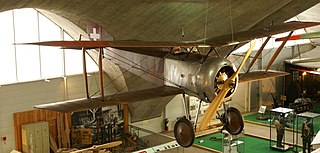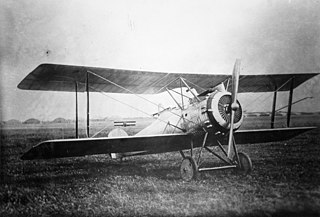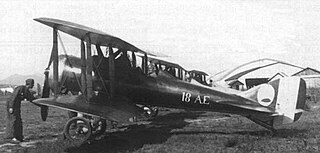Related Research Articles
The Adamoli-Cattani fighter was a prototype fighter aircraft designed as a private venture by two Italian aircraft builders in 1918.

The MB.210 and MB.211 were the successors of the French Bloch MB.200 bomber built by Societé des Avions Marcel Bloch in the 1930s and differed primarily in being low wing monoplanes rather than high wing monoplanes.

Hanriot H.230 was a French twin-engined advanced trainer. The construction of the aircraft was initiated in 1936 by Hanriot's chief designer Montlaur. The aircraft was produced by the nationalized factory SNCAC.

The Hanriot HD.1 was a French World War I single-seat fighter aircraft. Rejected for service with French squadrons in favour of the SPAD S.VII, the type was supplied to the Belgian Army′s Aviation Militaire Belge and the Royal Italian Army′s Corpo Aeronautico Militare, with both of which it proved highly successful. Of a total of about 1,200 examples built, 831 were produced by Italian companies under licence.

The Bartel BM.4 was a Polish biplane primary trainer aircraft used from 1929 to 1939 by the Polish Air Force and Polish civilian aviation, manufactured in the Samolot factory in Poznań. It was the first plane of Polish design put into production.

The Hanriot HD.2 was a biplane floatplane fighter aircraft produced in France during the First World War which was used after the war for testing the use of aircraft from warships.

The Hanriot HD.3 C.2 was a two-seat fighter aircraft produced in France during World War I.

The Hanriot HD.32 was a military trainer aircraft built in France in the 1920s. Derived from the HD.14 and sharing the same basic configuration as it, the HD.32 was a substantially revised design, with redesigned tailplane, undercarriage, and wings of shorter span. The HD.14's wooden construction was replaced in part with metal structure.

The Sikorsky S-20 or RBVZ S-XX was a Russian single-bay unequal span two-seat biplane designed by Igor Sikorsky in 1916. Displaying some Nieuport influence, it saw very little service during World War I.

The Farman NC.470 was a French twin-engined floatplane designed as a crew trainer for the French Navy. It was used in small numbers for both its intended role as a trainer and as a coastal reconnaissance aircraft at the start of World War II.

The Macchi M.14 was an Italian fighter of 1918 designed and manufactured by Macchi. The M.14 was the first non-seaplane fighter Macchi produced, its previous fighter production having focused on flying boat fighters.

The SNCAC NC.4-10 was a twin-engine floatplane torpedo bomber built in France in the late 1930s. It was one of several prototypes competing for an Admiralty specification but no contracts were awarded after the military lost interest in the type.
The Sopwith Swallow was a British parasol wing fighter aircraft of the First World War. A single example was built, but it saw no production, offering no performance advantages over contemporary biplanes.

The Nieuport-Delage NiD 32 was a French single-seater fighter produced by Nieuport during the period between the two World Wars. The aircraft was designed in response to a request from the French Navy for an aircraft capable of launching from a platform: the NiD 32 competed with other planes, such as the Hanriot HD.12 and the SPAD S.XV. In addition to the NiD 32, Nieuport also submitted the NiD 29. The Navy selected the Nieuport NiD 32, and set about to test it in March 1920 on a platform. The results were disappointing, as the platform could barely support the aircraft, even when it was unarmed.

The SNCAC NC-600 was a prototype French twin-engined long-range fighter aircraft, developed by SNCAC from the earlier Hanriot H.220 fighter. The type never entered service, with development being ended by the French surrender in June 1940.
The Ponnier M.1 was an early French World War I fighter aircraft Most of those produced were operated by the Aviation Militaire Belge. They were deemed unusable by the Belgian ace Willy Coppens and rapidly retired.
The Caudron 02 was a French high altitude single seat fighter that was flown in November 1917.

The Lorraine Hanriot LH.130 is a French racing aircraft designed and built in the early 1930s, to compete in the Coupe Michelin air races.
The Hanriot H.34 was a basic trainer designed in France in 1924 which did not reach production. It was a parasol wing aircraft, seating two in tandem.
The Hanriot H.33 was a French biplane 2-seat fighter aircraft built in 1926, derived from the Hanriot H.31. It was not successful and only one prototype was completed.
References
- Green, William; Gordon Swanborough. The Complete Book of Fighters. Godalming, UK: Salamander Books. p. 415.